Taxation 1 Report: R&D Incentives for Listed Companies
VerifiedAdded on 2020/05/28
|12
|2764
|35
Report
AI Summary
This report delves into the implications of Research and Development (R&D) incentives on listed companies in Australia, primarily focusing on the provisions of section 73A of the Income Tax Assessment Act, 1936 (ITAA, 1936) and Taxation Ruling (TR) 92/2. The analysis explores how these incentives, designed to encourage R&D spending, impact the financial performance and operational efficiency of businesses. The report discusses the types of expenditures eligible for tax deductions, including payments to approved research institutes and capital expenditures. It also highlights the conditions that listed companies must meet to leverage these tax benefits, such as maintaining proper records and adhering to income tax provisions. The findings suggest that R&D incentives have a positive impact, motivating increased R&D activities, improving operating efficiency, and enhancing the financial performance of listed entities, ultimately leading to better tax positions and compliance within the framework of ITAA.
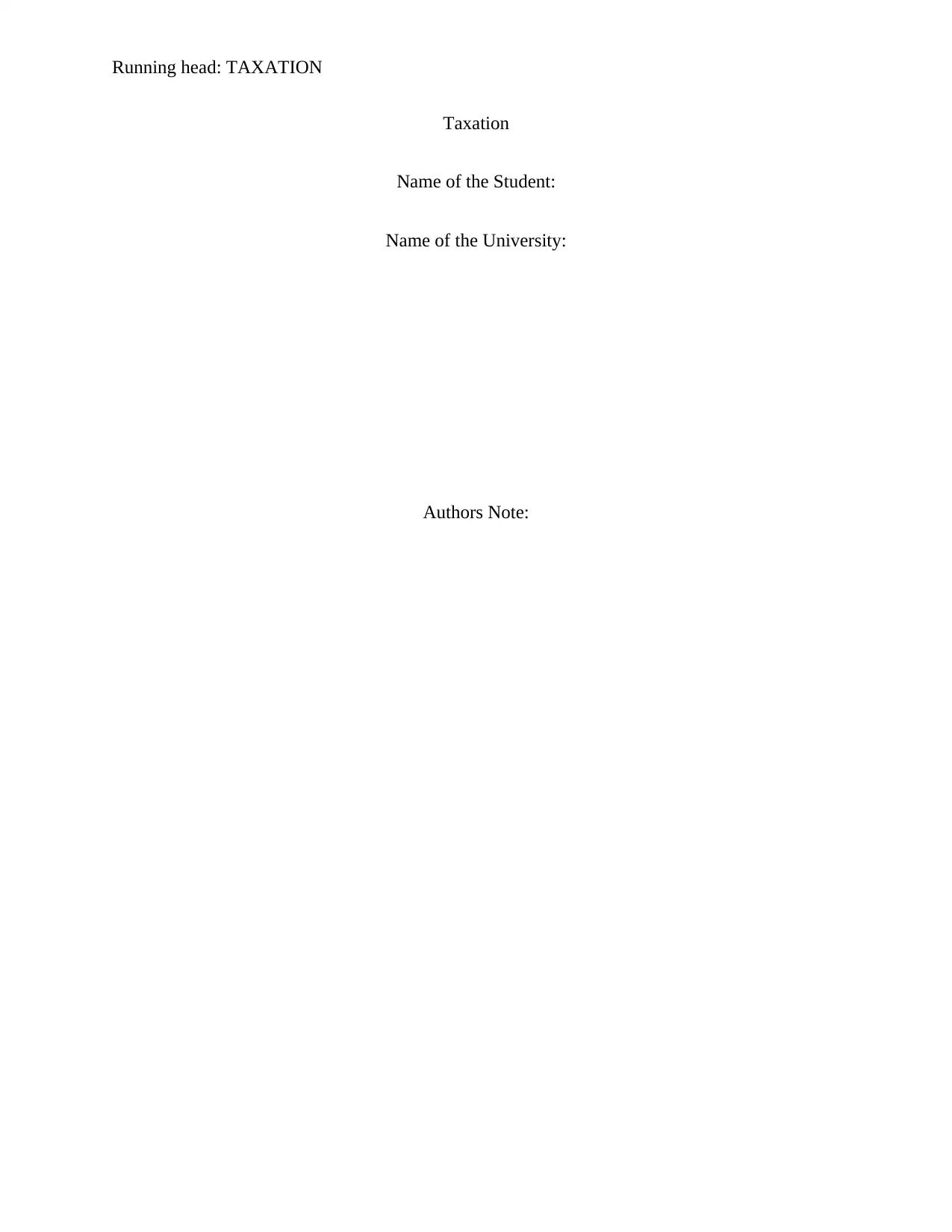
Running head: TAXATION
Taxation
Name of the Student:
Name of the University:
Authors Note:
Taxation
Name of the Student:
Name of the University:
Authors Note:
Paraphrase This Document
Need a fresh take? Get an instant paraphrase of this document with our AI Paraphraser
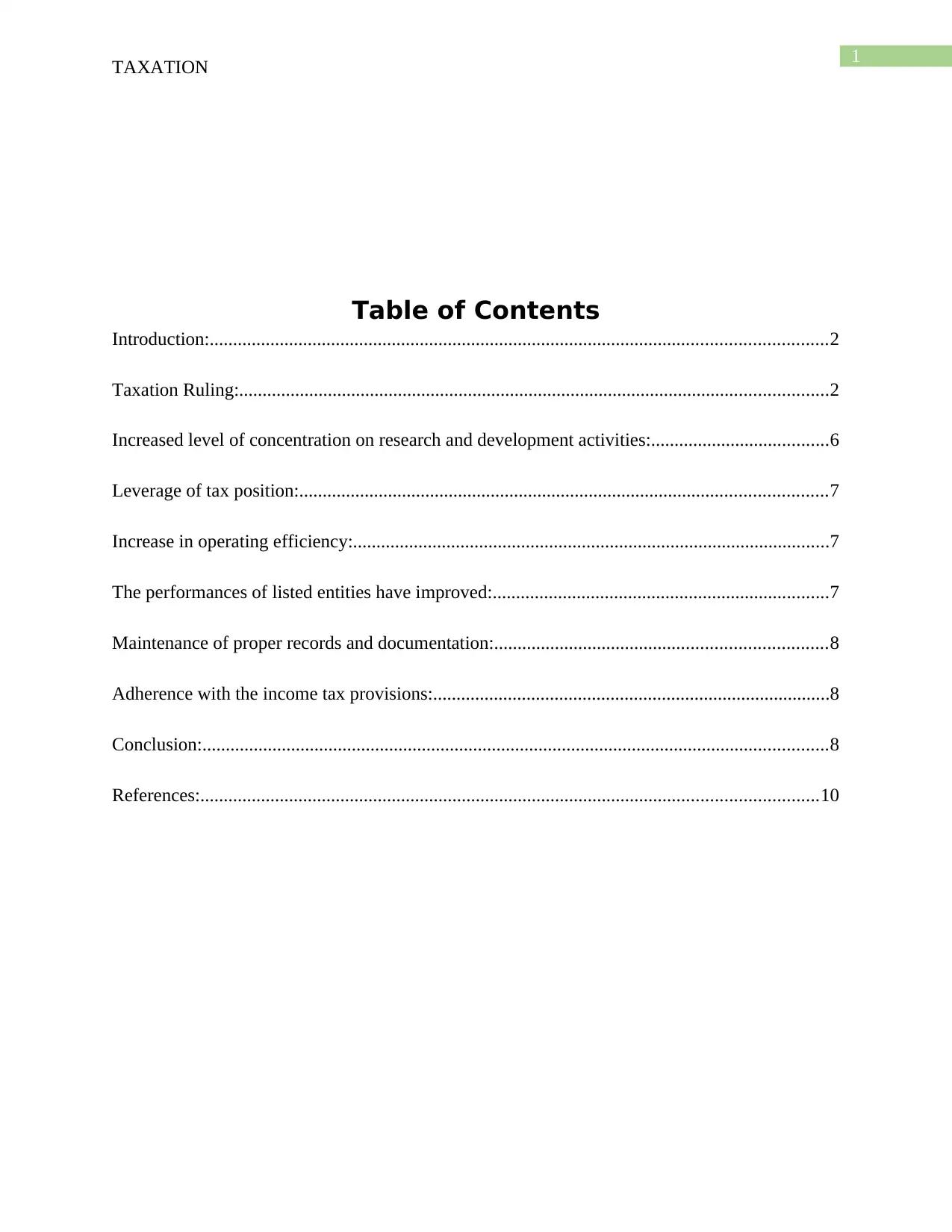
1
TAXATION
Table of Contents
Introduction:....................................................................................................................................2
Taxation Ruling:..............................................................................................................................2
Increased level of concentration on research and development activities:......................................6
Leverage of tax position:.................................................................................................................7
Increase in operating efficiency:......................................................................................................7
The performances of listed entities have improved:........................................................................7
Maintenance of proper records and documentation:.......................................................................8
Adherence with the income tax provisions:.....................................................................................8
Conclusion:......................................................................................................................................8
References:....................................................................................................................................10
TAXATION
Table of Contents
Introduction:....................................................................................................................................2
Taxation Ruling:..............................................................................................................................2
Increased level of concentration on research and development activities:......................................6
Leverage of tax position:.................................................................................................................7
Increase in operating efficiency:......................................................................................................7
The performances of listed entities have improved:........................................................................7
Maintenance of proper records and documentation:.......................................................................8
Adherence with the income tax provisions:.....................................................................................8
Conclusion:......................................................................................................................................8
References:....................................................................................................................................10
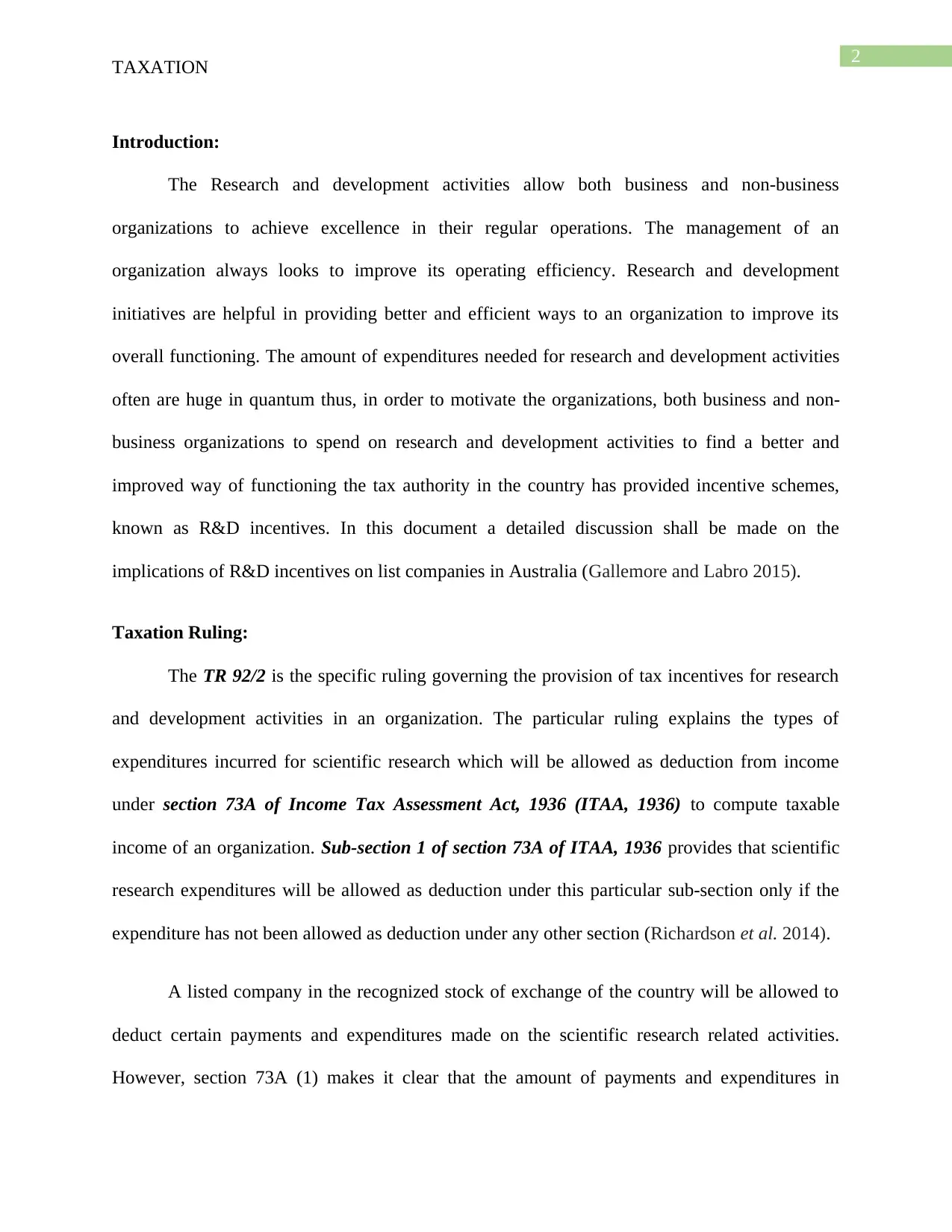
2
TAXATION
Introduction:
The Research and development activities allow both business and non-business
organizations to achieve excellence in their regular operations. The management of an
organization always looks to improve its operating efficiency. Research and development
initiatives are helpful in providing better and efficient ways to an organization to improve its
overall functioning. The amount of expenditures needed for research and development activities
often are huge in quantum thus, in order to motivate the organizations, both business and non-
business organizations to spend on research and development activities to find a better and
improved way of functioning the tax authority in the country has provided incentive schemes,
known as R&D incentives. In this document a detailed discussion shall be made on the
implications of R&D incentives on list companies in Australia (Gallemore and Labro 2015).
Taxation Ruling:
The TR 92/2 is the specific ruling governing the provision of tax incentives for research
and development activities in an organization. The particular ruling explains the types of
expenditures incurred for scientific research which will be allowed as deduction from income
under section 73A of Income Tax Assessment Act, 1936 (ITAA, 1936) to compute taxable
income of an organization. Sub-section 1 of section 73A of ITAA, 1936 provides that scientific
research expenditures will be allowed as deduction under this particular sub-section only if the
expenditure has not been allowed as deduction under any other section (Richardson et al. 2014).
A listed company in the recognized stock of exchange of the country will be allowed to
deduct certain payments and expenditures made on the scientific research related activities.
However, section 73A (1) makes it clear that the amount of payments and expenditures in
TAXATION
Introduction:
The Research and development activities allow both business and non-business
organizations to achieve excellence in their regular operations. The management of an
organization always looks to improve its operating efficiency. Research and development
initiatives are helpful in providing better and efficient ways to an organization to improve its
overall functioning. The amount of expenditures needed for research and development activities
often are huge in quantum thus, in order to motivate the organizations, both business and non-
business organizations to spend on research and development activities to find a better and
improved way of functioning the tax authority in the country has provided incentive schemes,
known as R&D incentives. In this document a detailed discussion shall be made on the
implications of R&D incentives on list companies in Australia (Gallemore and Labro 2015).
Taxation Ruling:
The TR 92/2 is the specific ruling governing the provision of tax incentives for research
and development activities in an organization. The particular ruling explains the types of
expenditures incurred for scientific research which will be allowed as deduction from income
under section 73A of Income Tax Assessment Act, 1936 (ITAA, 1936) to compute taxable
income of an organization. Sub-section 1 of section 73A of ITAA, 1936 provides that scientific
research expenditures will be allowed as deduction under this particular sub-section only if the
expenditure has not been allowed as deduction under any other section (Richardson et al. 2014).
A listed company in the recognized stock of exchange of the country will be allowed to
deduct certain payments and expenditures made on the scientific research related activities.
However, section 73A (1) makes it clear that the amount of payments and expenditures in
⊘ This is a preview!⊘
Do you want full access?
Subscribe today to unlock all pages.

Trusted by 1+ million students worldwide
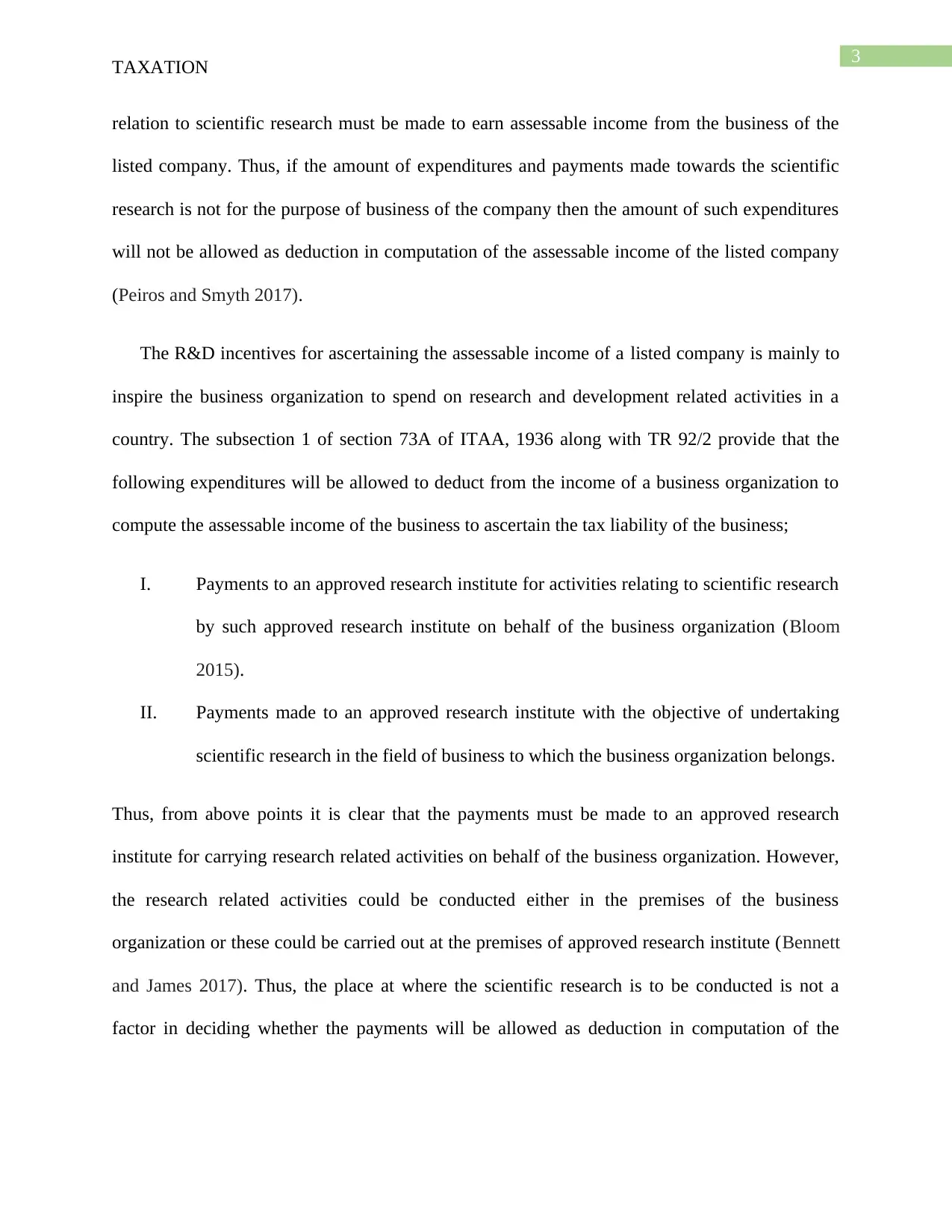
3
TAXATION
relation to scientific research must be made to earn assessable income from the business of the
listed company. Thus, if the amount of expenditures and payments made towards the scientific
research is not for the purpose of business of the company then the amount of such expenditures
will not be allowed as deduction in computation of the assessable income of the listed company
(Peiros and Smyth 2017).
The R&D incentives for ascertaining the assessable income of a listed company is mainly to
inspire the business organization to spend on research and development related activities in a
country. The subsection 1 of section 73A of ITAA, 1936 along with TR 92/2 provide that the
following expenditures will be allowed to deduct from the income of a business organization to
compute the assessable income of the business to ascertain the tax liability of the business;
I. Payments to an approved research institute for activities relating to scientific research
by such approved research institute on behalf of the business organization (Bloom
2015).
II. Payments made to an approved research institute with the objective of undertaking
scientific research in the field of business to which the business organization belongs.
Thus, from above points it is clear that the payments must be made to an approved research
institute for carrying research related activities on behalf of the business organization. However,
the research related activities could be conducted either in the premises of the business
organization or these could be carried out at the premises of approved research institute (Bennett
and James 2017). Thus, the place at where the scientific research is to be conducted is not a
factor in deciding whether the payments will be allowed as deduction in computation of the
TAXATION
relation to scientific research must be made to earn assessable income from the business of the
listed company. Thus, if the amount of expenditures and payments made towards the scientific
research is not for the purpose of business of the company then the amount of such expenditures
will not be allowed as deduction in computation of the assessable income of the listed company
(Peiros and Smyth 2017).
The R&D incentives for ascertaining the assessable income of a listed company is mainly to
inspire the business organization to spend on research and development related activities in a
country. The subsection 1 of section 73A of ITAA, 1936 along with TR 92/2 provide that the
following expenditures will be allowed to deduct from the income of a business organization to
compute the assessable income of the business to ascertain the tax liability of the business;
I. Payments to an approved research institute for activities relating to scientific research
by such approved research institute on behalf of the business organization (Bloom
2015).
II. Payments made to an approved research institute with the objective of undertaking
scientific research in the field of business to which the business organization belongs.
Thus, from above points it is clear that the payments must be made to an approved research
institute for carrying research related activities on behalf of the business organization. However,
the research related activities could be conducted either in the premises of the business
organization or these could be carried out at the premises of approved research institute (Bennett
and James 2017). Thus, the place at where the scientific research is to be conducted is not a
factor in deciding whether the payments will be allowed as deduction in computation of the
Paraphrase This Document
Need a fresh take? Get an instant paraphrase of this document with our AI Paraphraser
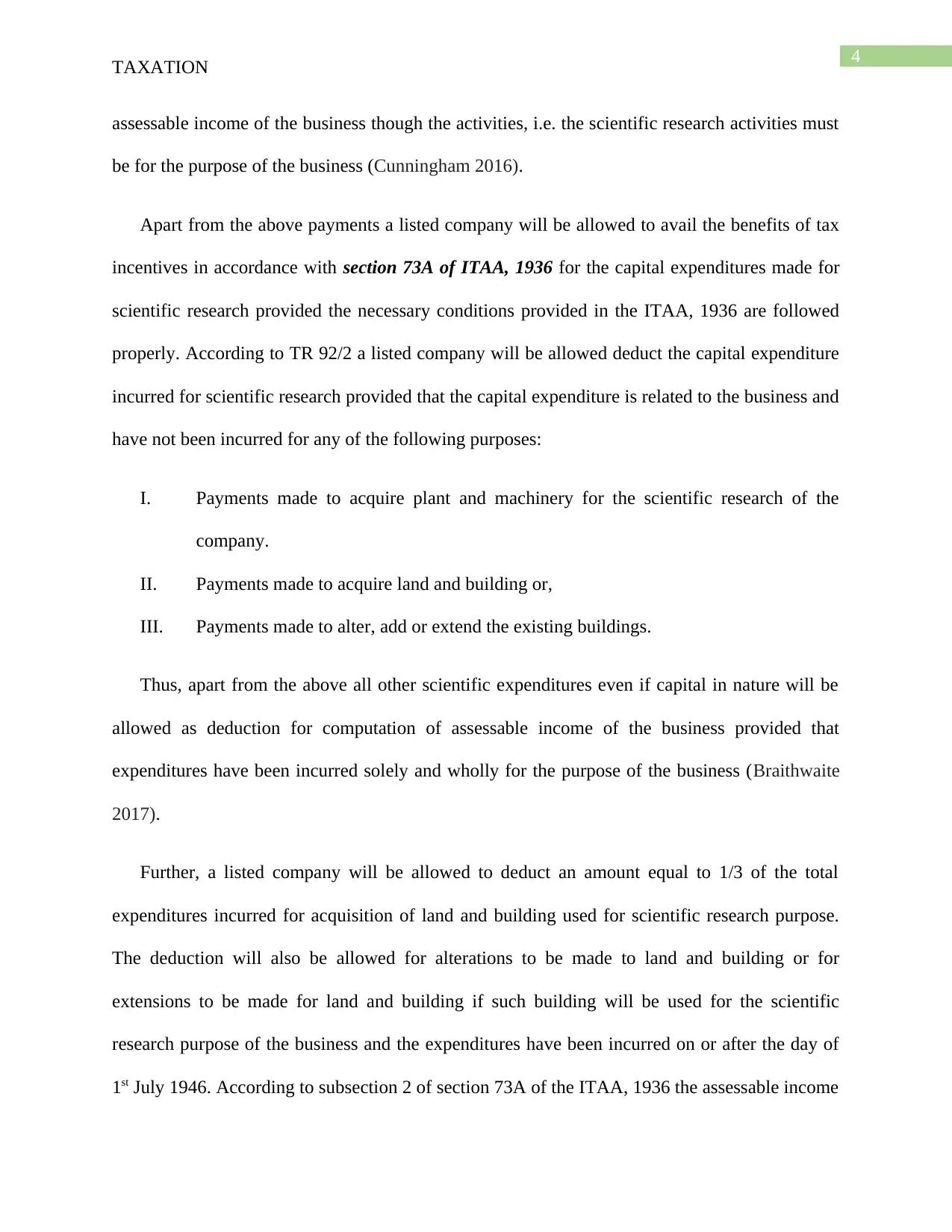
4
TAXATION
assessable income of the business though the activities, i.e. the scientific research activities must
be for the purpose of the business (Cunningham 2016).
Apart from the above payments a listed company will be allowed to avail the benefits of tax
incentives in accordance with section 73A of ITAA, 1936 for the capital expenditures made for
scientific research provided the necessary conditions provided in the ITAA, 1936 are followed
properly. According to TR 92/2 a listed company will be allowed deduct the capital expenditure
incurred for scientific research provided that the capital expenditure is related to the business and
have not been incurred for any of the following purposes:
I. Payments made to acquire plant and machinery for the scientific research of the
company.
II. Payments made to acquire land and building or,
III. Payments made to alter, add or extend the existing buildings.
Thus, apart from the above all other scientific expenditures even if capital in nature will be
allowed as deduction for computation of assessable income of the business provided that
expenditures have been incurred solely and wholly for the purpose of the business (Braithwaite
2017).
Further, a listed company will be allowed to deduct an amount equal to 1/3 of the total
expenditures incurred for acquisition of land and building used for scientific research purpose.
The deduction will also be allowed for alterations to be made to land and building or for
extensions to be made for land and building if such building will be used for the scientific
research purpose of the business and the expenditures have been incurred on or after the day of
1st July 1946. According to subsection 2 of section 73A of the ITAA, 1936 the assessable income
TAXATION
assessable income of the business though the activities, i.e. the scientific research activities must
be for the purpose of the business (Cunningham 2016).
Apart from the above payments a listed company will be allowed to avail the benefits of tax
incentives in accordance with section 73A of ITAA, 1936 for the capital expenditures made for
scientific research provided the necessary conditions provided in the ITAA, 1936 are followed
properly. According to TR 92/2 a listed company will be allowed deduct the capital expenditure
incurred for scientific research provided that the capital expenditure is related to the business and
have not been incurred for any of the following purposes:
I. Payments made to acquire plant and machinery for the scientific research of the
company.
II. Payments made to acquire land and building or,
III. Payments made to alter, add or extend the existing buildings.
Thus, apart from the above all other scientific expenditures even if capital in nature will be
allowed as deduction for computation of assessable income of the business provided that
expenditures have been incurred solely and wholly for the purpose of the business (Braithwaite
2017).
Further, a listed company will be allowed to deduct an amount equal to 1/3 of the total
expenditures incurred for acquisition of land and building used for scientific research purpose.
The deduction will also be allowed for alterations to be made to land and building or for
extensions to be made for land and building if such building will be used for the scientific
research purpose of the business and the expenditures have been incurred on or after the day of
1st July 1946. According to subsection 2 of section 73A of the ITAA, 1936 the assessable income
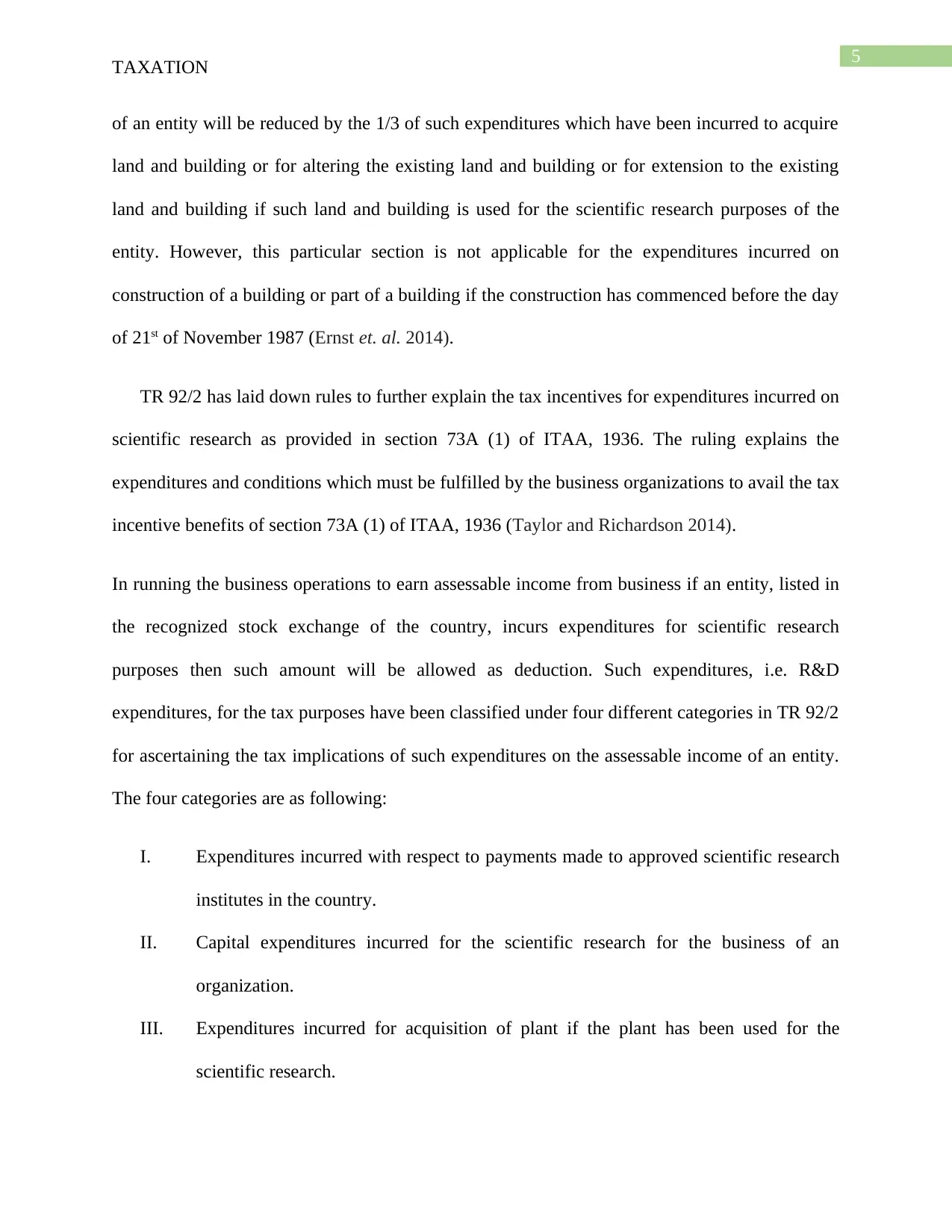
5
TAXATION
of an entity will be reduced by the 1/3 of such expenditures which have been incurred to acquire
land and building or for altering the existing land and building or for extension to the existing
land and building if such land and building is used for the scientific research purposes of the
entity. However, this particular section is not applicable for the expenditures incurred on
construction of a building or part of a building if the construction has commenced before the day
of 21st of November 1987 (Ernst et. al. 2014).
TR 92/2 has laid down rules to further explain the tax incentives for expenditures incurred on
scientific research as provided in section 73A (1) of ITAA, 1936. The ruling explains the
expenditures and conditions which must be fulfilled by the business organizations to avail the tax
incentive benefits of section 73A (1) of ITAA, 1936 (Taylor and Richardson 2014).
In running the business operations to earn assessable income from business if an entity, listed in
the recognized stock exchange of the country, incurs expenditures for scientific research
purposes then such amount will be allowed as deduction. Such expenditures, i.e. R&D
expenditures, for the tax purposes have been classified under four different categories in TR 92/2
for ascertaining the tax implications of such expenditures on the assessable income of an entity.
The four categories are as following:
I. Expenditures incurred with respect to payments made to approved scientific research
institutes in the country.
II. Capital expenditures incurred for the scientific research for the business of an
organization.
III. Expenditures incurred for acquisition of plant if the plant has been used for the
scientific research.
TAXATION
of an entity will be reduced by the 1/3 of such expenditures which have been incurred to acquire
land and building or for altering the existing land and building or for extension to the existing
land and building if such land and building is used for the scientific research purposes of the
entity. However, this particular section is not applicable for the expenditures incurred on
construction of a building or part of a building if the construction has commenced before the day
of 21st of November 1987 (Ernst et. al. 2014).
TR 92/2 has laid down rules to further explain the tax incentives for expenditures incurred on
scientific research as provided in section 73A (1) of ITAA, 1936. The ruling explains the
expenditures and conditions which must be fulfilled by the business organizations to avail the tax
incentive benefits of section 73A (1) of ITAA, 1936 (Taylor and Richardson 2014).
In running the business operations to earn assessable income from business if an entity, listed in
the recognized stock exchange of the country, incurs expenditures for scientific research
purposes then such amount will be allowed as deduction. Such expenditures, i.e. R&D
expenditures, for the tax purposes have been classified under four different categories in TR 92/2
for ascertaining the tax implications of such expenditures on the assessable income of an entity.
The four categories are as following:
I. Expenditures incurred with respect to payments made to approved scientific research
institutes in the country.
II. Capital expenditures incurred for the scientific research for the business of an
organization.
III. Expenditures incurred for acquisition of plant if the plant has been used for the
scientific research.
⊘ This is a preview!⊘
Do you want full access?
Subscribe today to unlock all pages.

Trusted by 1+ million students worldwide
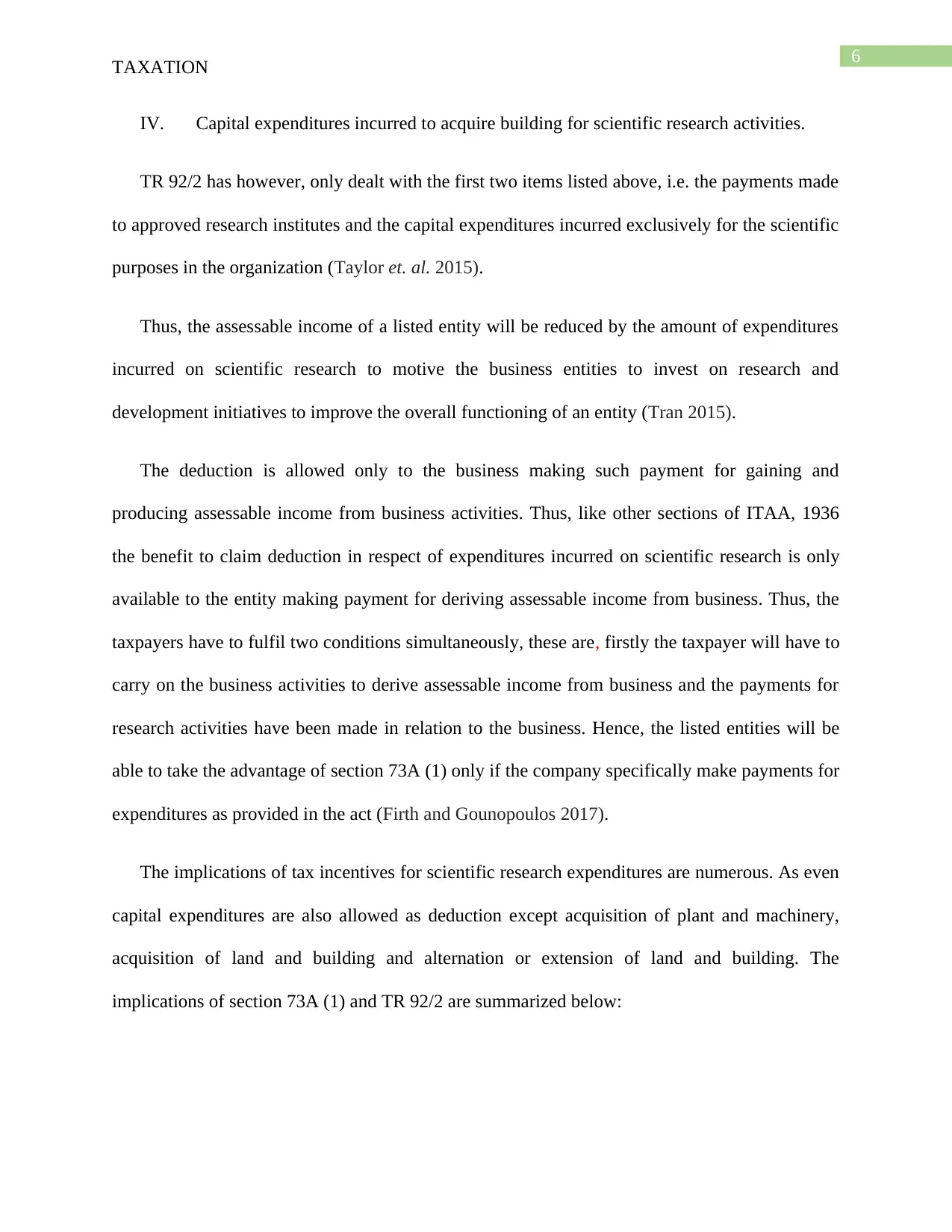
6
TAXATION
IV. Capital expenditures incurred to acquire building for scientific research activities.
TR 92/2 has however, only dealt with the first two items listed above, i.e. the payments made
to approved research institutes and the capital expenditures incurred exclusively for the scientific
purposes in the organization (Taylor et. al. 2015).
Thus, the assessable income of a listed entity will be reduced by the amount of expenditures
incurred on scientific research to motive the business entities to invest on research and
development initiatives to improve the overall functioning of an entity (Tran 2015).
The deduction is allowed only to the business making such payment for gaining and
producing assessable income from business activities. Thus, like other sections of ITAA, 1936
the benefit to claim deduction in respect of expenditures incurred on scientific research is only
available to the entity making payment for deriving assessable income from business. Thus, the
taxpayers have to fulfil two conditions simultaneously, these are, firstly the taxpayer will have to
carry on the business activities to derive assessable income from business and the payments for
research activities have been made in relation to the business. Hence, the listed entities will be
able to take the advantage of section 73A (1) only if the company specifically make payments for
expenditures as provided in the act (Firth and Gounopoulos 2017).
The implications of tax incentives for scientific research expenditures are numerous. As even
capital expenditures are also allowed as deduction except acquisition of plant and machinery,
acquisition of land and building and alternation or extension of land and building. The
implications of section 73A (1) and TR 92/2 are summarized below:
TAXATION
IV. Capital expenditures incurred to acquire building for scientific research activities.
TR 92/2 has however, only dealt with the first two items listed above, i.e. the payments made
to approved research institutes and the capital expenditures incurred exclusively for the scientific
purposes in the organization (Taylor et. al. 2015).
Thus, the assessable income of a listed entity will be reduced by the amount of expenditures
incurred on scientific research to motive the business entities to invest on research and
development initiatives to improve the overall functioning of an entity (Tran 2015).
The deduction is allowed only to the business making such payment for gaining and
producing assessable income from business activities. Thus, like other sections of ITAA, 1936
the benefit to claim deduction in respect of expenditures incurred on scientific research is only
available to the entity making payment for deriving assessable income from business. Thus, the
taxpayers have to fulfil two conditions simultaneously, these are, firstly the taxpayer will have to
carry on the business activities to derive assessable income from business and the payments for
research activities have been made in relation to the business. Hence, the listed entities will be
able to take the advantage of section 73A (1) only if the company specifically make payments for
expenditures as provided in the act (Firth and Gounopoulos 2017).
The implications of tax incentives for scientific research expenditures are numerous. As even
capital expenditures are also allowed as deduction except acquisition of plant and machinery,
acquisition of land and building and alternation or extension of land and building. The
implications of section 73A (1) and TR 92/2 are summarized below:
Paraphrase This Document
Need a fresh take? Get an instant paraphrase of this document with our AI Paraphraser
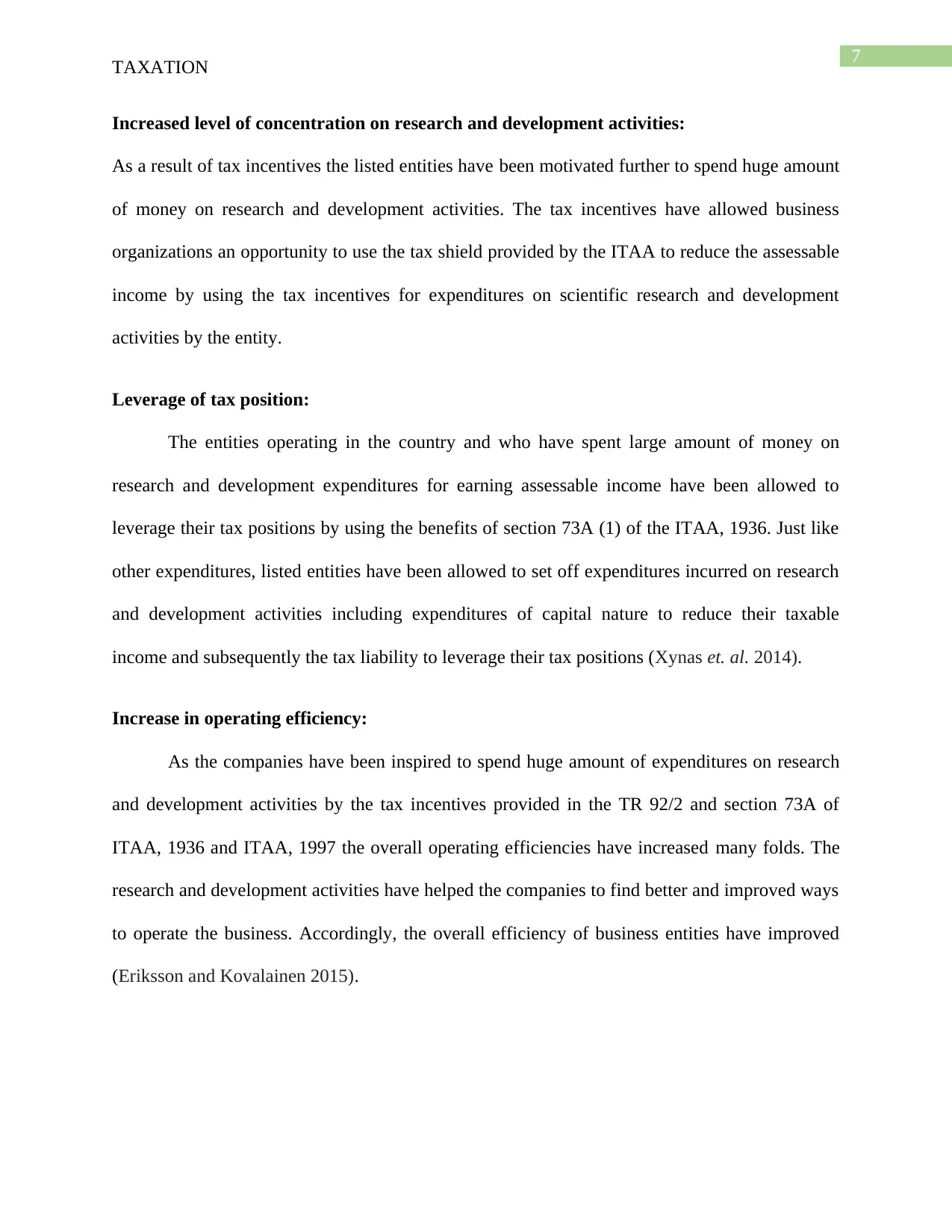
7
TAXATION
Increased level of concentration on research and development activities:
As a result of tax incentives the listed entities have been motivated further to spend huge amount
of money on research and development activities. The tax incentives have allowed business
organizations an opportunity to use the tax shield provided by the ITAA to reduce the assessable
income by using the tax incentives for expenditures on scientific research and development
activities by the entity.
Leverage of tax position:
The entities operating in the country and who have spent large amount of money on
research and development expenditures for earning assessable income have been allowed to
leverage their tax positions by using the benefits of section 73A (1) of the ITAA, 1936. Just like
other expenditures, listed entities have been allowed to set off expenditures incurred on research
and development activities including expenditures of capital nature to reduce their taxable
income and subsequently the tax liability to leverage their tax positions (Xynas et. al. 2014).
Increase in operating efficiency:
As the companies have been inspired to spend huge amount of expenditures on research
and development activities by the tax incentives provided in the TR 92/2 and section 73A of
ITAA, 1936 and ITAA, 1997 the overall operating efficiencies have increased many folds. The
research and development activities have helped the companies to find better and improved ways
to operate the business. Accordingly, the overall efficiency of business entities have improved
(Eriksson and Kovalainen 2015).
TAXATION
Increased level of concentration on research and development activities:
As a result of tax incentives the listed entities have been motivated further to spend huge amount
of money on research and development activities. The tax incentives have allowed business
organizations an opportunity to use the tax shield provided by the ITAA to reduce the assessable
income by using the tax incentives for expenditures on scientific research and development
activities by the entity.
Leverage of tax position:
The entities operating in the country and who have spent large amount of money on
research and development expenditures for earning assessable income have been allowed to
leverage their tax positions by using the benefits of section 73A (1) of the ITAA, 1936. Just like
other expenditures, listed entities have been allowed to set off expenditures incurred on research
and development activities including expenditures of capital nature to reduce their taxable
income and subsequently the tax liability to leverage their tax positions (Xynas et. al. 2014).
Increase in operating efficiency:
As the companies have been inspired to spend huge amount of expenditures on research
and development activities by the tax incentives provided in the TR 92/2 and section 73A of
ITAA, 1936 and ITAA, 1997 the overall operating efficiencies have increased many folds. The
research and development activities have helped the companies to find better and improved ways
to operate the business. Accordingly, the overall efficiency of business entities have improved
(Eriksson and Kovalainen 2015).
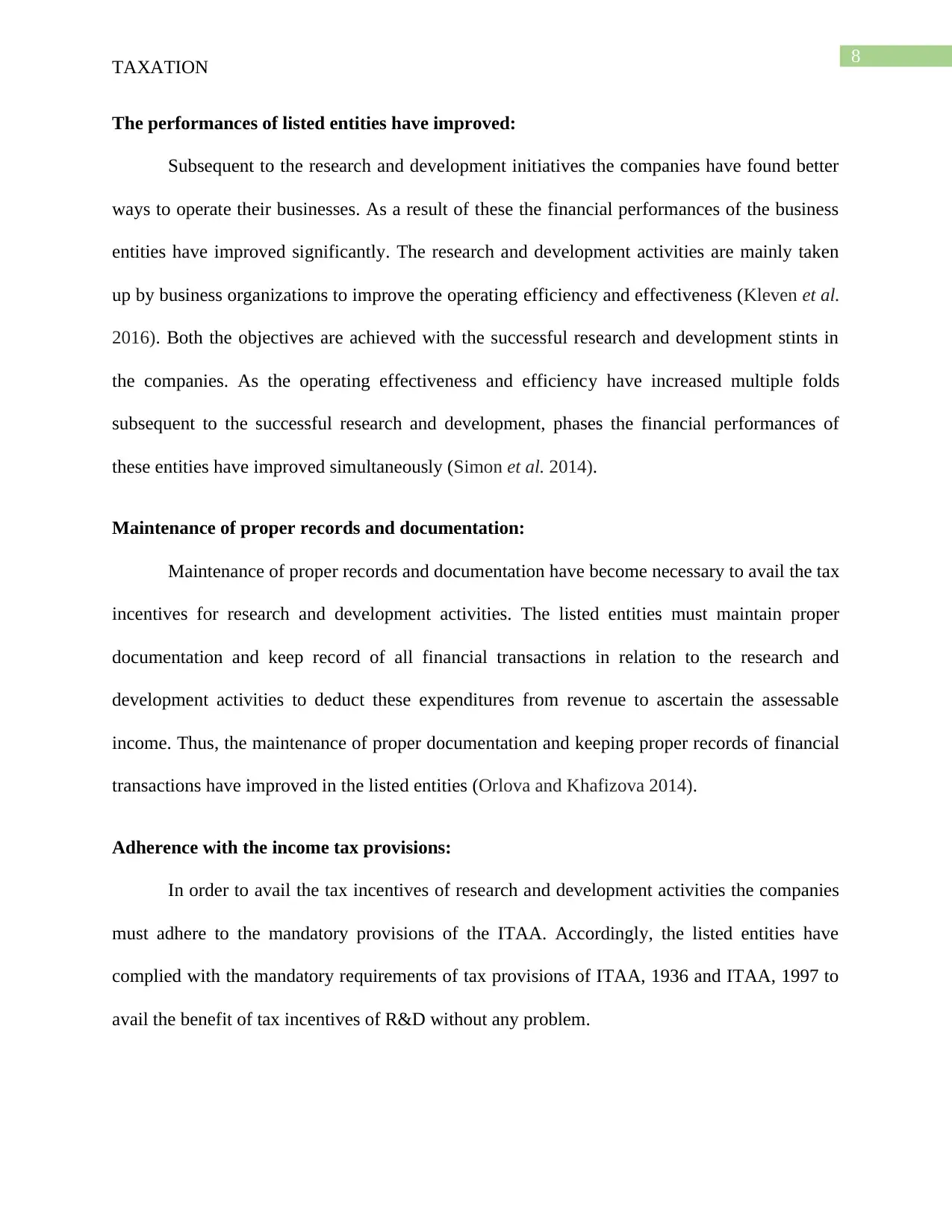
8
TAXATION
The performances of listed entities have improved:
Subsequent to the research and development initiatives the companies have found better
ways to operate their businesses. As a result of these the financial performances of the business
entities have improved significantly. The research and development activities are mainly taken
up by business organizations to improve the operating efficiency and effectiveness (Kleven et al.
2016). Both the objectives are achieved with the successful research and development stints in
the companies. As the operating effectiveness and efficiency have increased multiple folds
subsequent to the successful research and development, phases the financial performances of
these entities have improved simultaneously (Simon et al. 2014).
Maintenance of proper records and documentation:
Maintenance of proper records and documentation have become necessary to avail the tax
incentives for research and development activities. The listed entities must maintain proper
documentation and keep record of all financial transactions in relation to the research and
development activities to deduct these expenditures from revenue to ascertain the assessable
income. Thus, the maintenance of proper documentation and keeping proper records of financial
transactions have improved in the listed entities (Orlova and Khafizova 2014).
Adherence with the income tax provisions:
In order to avail the tax incentives of research and development activities the companies
must adhere to the mandatory provisions of the ITAA. Accordingly, the listed entities have
complied with the mandatory requirements of tax provisions of ITAA, 1936 and ITAA, 1997 to
avail the benefit of tax incentives of R&D without any problem.
TAXATION
The performances of listed entities have improved:
Subsequent to the research and development initiatives the companies have found better
ways to operate their businesses. As a result of these the financial performances of the business
entities have improved significantly. The research and development activities are mainly taken
up by business organizations to improve the operating efficiency and effectiveness (Kleven et al.
2016). Both the objectives are achieved with the successful research and development stints in
the companies. As the operating effectiveness and efficiency have increased multiple folds
subsequent to the successful research and development, phases the financial performances of
these entities have improved simultaneously (Simon et al. 2014).
Maintenance of proper records and documentation:
Maintenance of proper records and documentation have become necessary to avail the tax
incentives for research and development activities. The listed entities must maintain proper
documentation and keep record of all financial transactions in relation to the research and
development activities to deduct these expenditures from revenue to ascertain the assessable
income. Thus, the maintenance of proper documentation and keeping proper records of financial
transactions have improved in the listed entities (Orlova and Khafizova 2014).
Adherence with the income tax provisions:
In order to avail the tax incentives of research and development activities the companies
must adhere to the mandatory provisions of the ITAA. Accordingly, the listed entities have
complied with the mandatory requirements of tax provisions of ITAA, 1936 and ITAA, 1997 to
avail the benefit of tax incentives of R&D without any problem.
⊘ This is a preview!⊘
Do you want full access?
Subscribe today to unlock all pages.

Trusted by 1+ million students worldwide
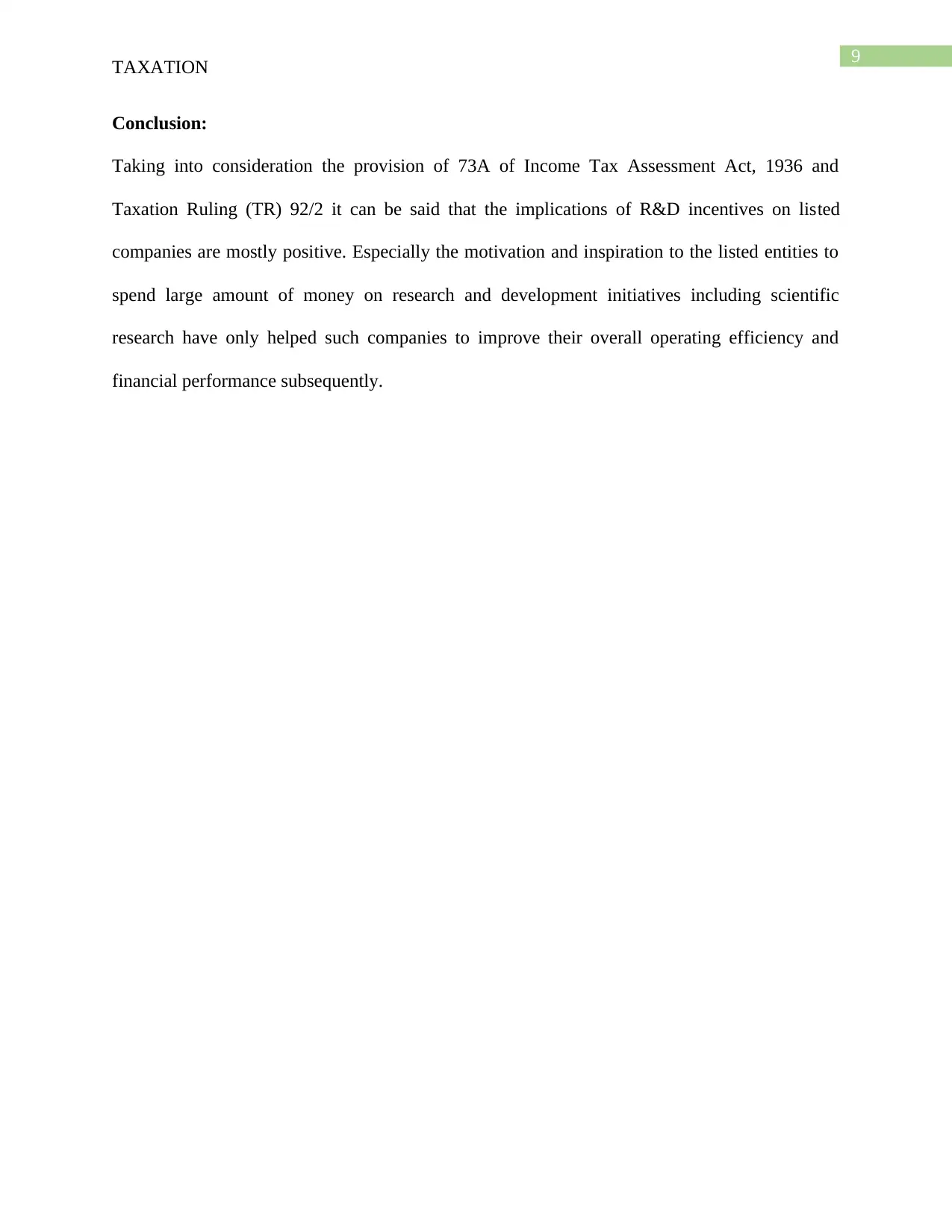
9
TAXATION
Conclusion:
Taking into consideration the provision of 73A of Income Tax Assessment Act, 1936 and
Taxation Ruling (TR) 92/2 it can be said that the implications of R&D incentives on listed
companies are mostly positive. Especially the motivation and inspiration to the listed entities to
spend large amount of money on research and development initiatives including scientific
research have only helped such companies to improve their overall operating efficiency and
financial performance subsequently.
TAXATION
Conclusion:
Taking into consideration the provision of 73A of Income Tax Assessment Act, 1936 and
Taxation Ruling (TR) 92/2 it can be said that the implications of R&D incentives on listed
companies are mostly positive. Especially the motivation and inspiration to the listed entities to
spend large amount of money on research and development initiatives including scientific
research have only helped such companies to improve their overall operating efficiency and
financial performance subsequently.
Paraphrase This Document
Need a fresh take? Get an instant paraphrase of this document with our AI Paraphraser
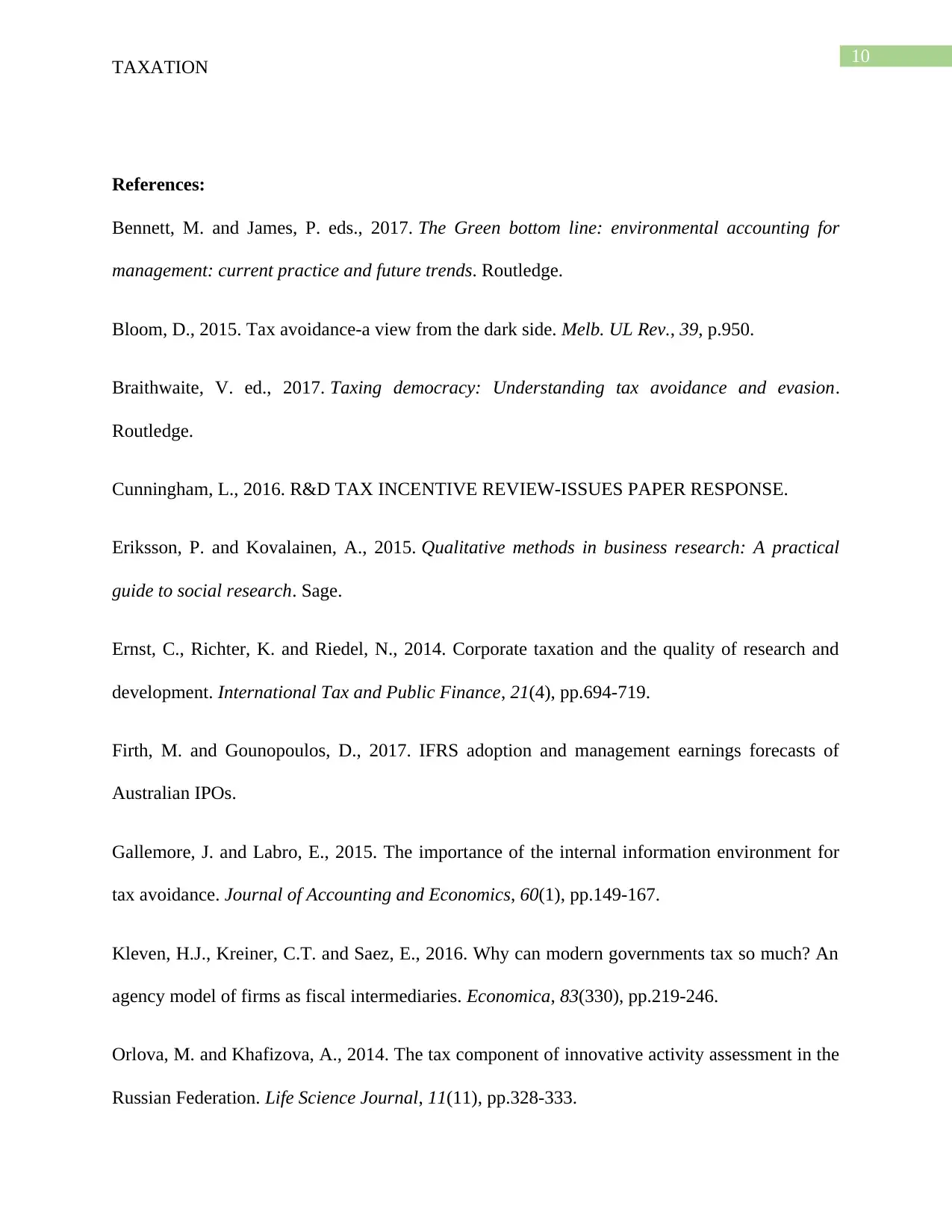
10
TAXATION
References:
Bennett, M. and James, P. eds., 2017. The Green bottom line: environmental accounting for
management: current practice and future trends. Routledge.
Bloom, D., 2015. Tax avoidance-a view from the dark side. Melb. UL Rev., 39, p.950.
Braithwaite, V. ed., 2017. Taxing democracy: Understanding tax avoidance and evasion.
Routledge.
Cunningham, L., 2016. R&D TAX INCENTIVE REVIEW-ISSUES PAPER RESPONSE.
Eriksson, P. and Kovalainen, A., 2015. Qualitative methods in business research: A practical
guide to social research. Sage.
Ernst, C., Richter, K. and Riedel, N., 2014. Corporate taxation and the quality of research and
development. International Tax and Public Finance, 21(4), pp.694-719.
Firth, M. and Gounopoulos, D., 2017. IFRS adoption and management earnings forecasts of
Australian IPOs.
Gallemore, J. and Labro, E., 2015. The importance of the internal information environment for
tax avoidance. Journal of Accounting and Economics, 60(1), pp.149-167.
Kleven, H.J., Kreiner, C.T. and Saez, E., 2016. Why can modern governments tax so much? An
agency model of firms as fiscal intermediaries. Economica, 83(330), pp.219-246.
Orlova, M. and Khafizova, A., 2014. The tax component of innovative activity assessment in the
Russian Federation. Life Science Journal, 11(11), pp.328-333.
TAXATION
References:
Bennett, M. and James, P. eds., 2017. The Green bottom line: environmental accounting for
management: current practice and future trends. Routledge.
Bloom, D., 2015. Tax avoidance-a view from the dark side. Melb. UL Rev., 39, p.950.
Braithwaite, V. ed., 2017. Taxing democracy: Understanding tax avoidance and evasion.
Routledge.
Cunningham, L., 2016. R&D TAX INCENTIVE REVIEW-ISSUES PAPER RESPONSE.
Eriksson, P. and Kovalainen, A., 2015. Qualitative methods in business research: A practical
guide to social research. Sage.
Ernst, C., Richter, K. and Riedel, N., 2014. Corporate taxation and the quality of research and
development. International Tax and Public Finance, 21(4), pp.694-719.
Firth, M. and Gounopoulos, D., 2017. IFRS adoption and management earnings forecasts of
Australian IPOs.
Gallemore, J. and Labro, E., 2015. The importance of the internal information environment for
tax avoidance. Journal of Accounting and Economics, 60(1), pp.149-167.
Kleven, H.J., Kreiner, C.T. and Saez, E., 2016. Why can modern governments tax so much? An
agency model of firms as fiscal intermediaries. Economica, 83(330), pp.219-246.
Orlova, M. and Khafizova, A., 2014. The tax component of innovative activity assessment in the
Russian Federation. Life Science Journal, 11(11), pp.328-333.
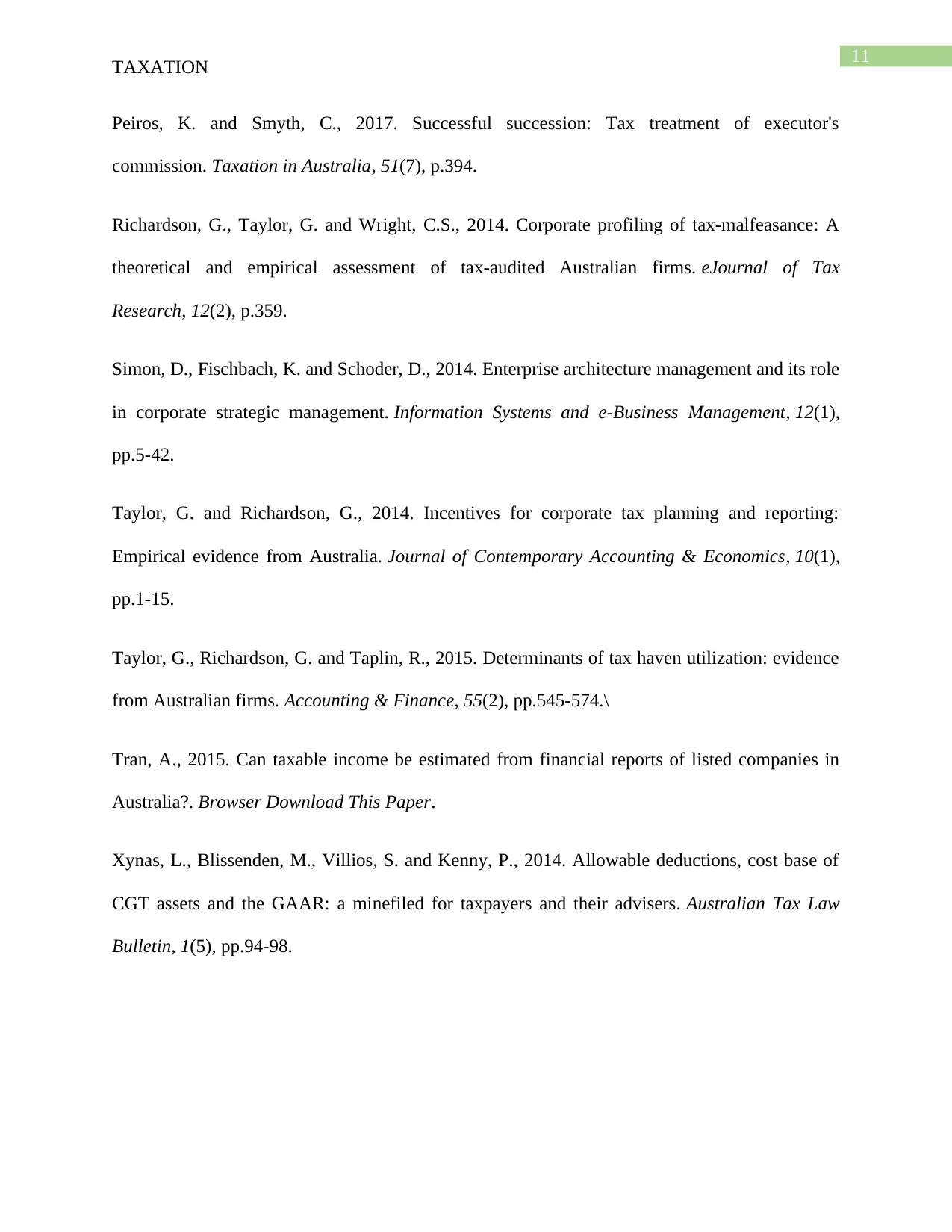
11
TAXATION
Peiros, K. and Smyth, C., 2017. Successful succession: Tax treatment of executor's
commission. Taxation in Australia, 51(7), p.394.
Richardson, G., Taylor, G. and Wright, C.S., 2014. Corporate profiling of tax-malfeasance: A
theoretical and empirical assessment of tax-audited Australian firms. eJournal of Tax
Research, 12(2), p.359.
Simon, D., Fischbach, K. and Schoder, D., 2014. Enterprise architecture management and its role
in corporate strategic management. Information Systems and e-Business Management, 12(1),
pp.5-42.
Taylor, G. and Richardson, G., 2014. Incentives for corporate tax planning and reporting:
Empirical evidence from Australia. Journal of Contemporary Accounting & Economics, 10(1),
pp.1-15.
Taylor, G., Richardson, G. and Taplin, R., 2015. Determinants of tax haven utilization: evidence
from Australian firms. Accounting & Finance, 55(2), pp.545-574.\
Tran, A., 2015. Can taxable income be estimated from financial reports of listed companies in
Australia?. Browser Download This Paper.
Xynas, L., Blissenden, M., Villios, S. and Kenny, P., 2014. Allowable deductions, cost base of
CGT assets and the GAAR: a minefiled for taxpayers and their advisers. Australian Tax Law
Bulletin, 1(5), pp.94-98.
TAXATION
Peiros, K. and Smyth, C., 2017. Successful succession: Tax treatment of executor's
commission. Taxation in Australia, 51(7), p.394.
Richardson, G., Taylor, G. and Wright, C.S., 2014. Corporate profiling of tax-malfeasance: A
theoretical and empirical assessment of tax-audited Australian firms. eJournal of Tax
Research, 12(2), p.359.
Simon, D., Fischbach, K. and Schoder, D., 2014. Enterprise architecture management and its role
in corporate strategic management. Information Systems and e-Business Management, 12(1),
pp.5-42.
Taylor, G. and Richardson, G., 2014. Incentives for corporate tax planning and reporting:
Empirical evidence from Australia. Journal of Contemporary Accounting & Economics, 10(1),
pp.1-15.
Taylor, G., Richardson, G. and Taplin, R., 2015. Determinants of tax haven utilization: evidence
from Australian firms. Accounting & Finance, 55(2), pp.545-574.\
Tran, A., 2015. Can taxable income be estimated from financial reports of listed companies in
Australia?. Browser Download This Paper.
Xynas, L., Blissenden, M., Villios, S. and Kenny, P., 2014. Allowable deductions, cost base of
CGT assets and the GAAR: a minefiled for taxpayers and their advisers. Australian Tax Law
Bulletin, 1(5), pp.94-98.
⊘ This is a preview!⊘
Do you want full access?
Subscribe today to unlock all pages.

Trusted by 1+ million students worldwide
1 out of 12
Related Documents
Your All-in-One AI-Powered Toolkit for Academic Success.
+13062052269
info@desklib.com
Available 24*7 on WhatsApp / Email
![[object Object]](/_next/static/media/star-bottom.7253800d.svg)
Unlock your academic potential
Copyright © 2020–2025 A2Z Services. All Rights Reserved. Developed and managed by ZUCOL.





